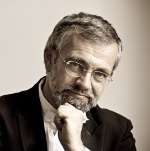Parsifal is the most intriguing of Wagner's stage works. With very little action over its six and a quarter hour duration (Bayreuth customarily allows an hour for each interval), the impact of this Bühnenweihfestspiel (sacred festival drama) greatly depends on the orchestra and its conductor, Semyon Bychkov, (both were excellent here) and the directorial concept. Uwe Eric Laufenberg’s production was first performed in 2016, shortly after several terrorist attacks in Germany and elsewhere. His message may even have been inspired by Beethoven’s famous line: “Alle Menschen werden Brüder” (All people become brothers). Nonetheless, rumours ran amok that his staging would include references, possibly insults, to followers of other religions, Jews or Muslims (dealing with the “other” seems to be one of the main challenges in current Bayreuth philosophy) and the security restrictions increased immensely. Sadly, police presence is still very visible around the Festspielhaus.
Laufenberg created a complex production. At times hard to figure out (why are three puppet-humans sitting prominently at the top of the stage?), occasionally plain silly (Parsifal, the US sniper, puts his machine gun down in order to be able to catch Klingsor’s spear with his hands), maybe even grotesque (our sniper, sporting sunglasses, sitting down with a bunch of Islamic ladies dressed in abaya, who later turn themselves into Ottoman harem ladies in the Flowermaidens scene), but it is constantly thought provoking and its basic premises are never contrary to the score.
Gisbert Jäkel’s sets and Jessica Karge’s costumes place the beginning of the work in a bombed-out monastery in Kurdistan (as it will be clearly shown later in Gérard Naziri’s impressive video). Refugees – such a loaded term in our times – sleep everywhere, but are woken up by monks, whose leader is Gurnemanz, in Günther Groissböck‘s commanding performance, dressed as an Imam. For good measure, US special forces walk across the stage, carrying a sculpture of Jesus on the cross. Kundry first appears wearing a burka. Strikingly, however, the different cultures and different religions do not clash but co-exist, a message mostly overlooked in previous commentaries about this production.
Wagner’s work is ambiguous about Christianity (despite obvious references, Jesus is never named other than the Redeemer) and Laufenberg expands on this ambiguity. In his reading, he overlaps the wound of Amfortas with that of Christ. As a result, a startlingly beautiful scene of Act 1 is created where Amfortas (Ryan McKinny expressing the eternal pain with both his movements and his sensitive singing), wearing a white loin cloth and a crown of thorns, is standing and the Holy Grail is used for its original purpose, to receive the blood of his never-healing wound, and then used for holy communion by the monks, observed by Muslims and Jews alike.
Act 2 takes the audience into a Muslim bathhouse. We know this, not only because of the tiled surfaces and the spa in the corner but because Klingsor turns his praying rug towards Mecca and kneels on it. Neither Derek Welton’s tone nor his presentation of the evil sorcerer is quite as dark as one might wish. As the only negative figure, his self-flagellation notwithstanding, more vicious weight would better balance the drama. His dramatic role is challenged by him having a crucifix collection in his upstairs room. If he is so familiar with these objects, why does he die when Parsifal shows another cross to him made of the broken pieces of his spear, at the conclusion of the act?
Kundry dominates much of this act. Elena Pankratova, only one day after her Ortrud in Lohengrin, was in strong vocal form with no signs of holding back. Powerful in phrasing and volume, she was matched by Andreas Schager’s Parsifal, who hears his name first from the seductress. Schager fits well into the current range of Wagner tenors, seen and heard over the last week. His preparation is as unquestionable as is his seemingly endless stamina. The voice is clear and resonant, but the tonal shine that defined the Heldentenor voices of past times, is seldom evident. Yet at times, for example, in his pained “Amfortas! Die Wunde!” (Amfortas, the wound!) outcry, his singing was powerful and touching.
Following the score’s instructions, Act 3 takes place many years later, with a stooped Gurnemanz and a greyed hair Kundry waiting for the Redeemer, who indeed arrives, this time in black fatigues. While the role of naked actors dancing in the rain during the Good Friday Music remains unclear, the final scene, with the wound of Amfortas healed and Christian and Jewish and Muslim people celebrating together is cathartic, helped by the brilliant chorus work (prepared by the the unsurmountable Eberhard Friedrich).
Laufenberg’s production, despite its enigmatic details, is carefully designed. Nevertheless, the question Gurnemanz proposes to Parsifal at the end of Act 1, resonated with new meaning as I was walking down from the Green Hill: “Do you understand what you have seen?”




